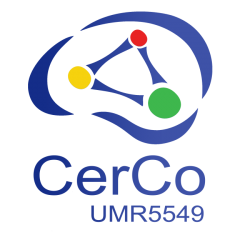Head : Isabelle BERRY
The Brain and Cognition Research Center in Toulouse (CerCo) is a research unit created by the CNRS and the Université Paul Sabatier (Toulouse 3) with over 30 research scientists working on different aspect of brain function , 40 doctoral and post-doctoral students and a technical team with 8 members working on 5 main research topics.
DYNAMO – Neural Dynamics of Memory and Object Processing
PresAge – Predictive Markers in Ageing and Neurodegeneration
SV3M – Spatial Vision in Man, Monkey & Machine
SLAM – Social, learning, audition and multimodality
The CerCo scientific aim is to investigate in human and non-human primates the anatomy of the visual system, its functional architecture and the dynamics of visual computing, its interactions with other sensory modalities, and the neural basis of perception and higher cognitive functions such as representation of space, scenes and objects, attention, mental states and consciousness.
The specificity of CerCo scientific projects includes :
- a parallel approach in monkeys, humans and patients, bridging fundamental research and clinical research,
- a multi-level approach (neurones, neuronal populations, cerebral networks, whole organisms)
- a multi-disciplinary approach using a wide range of convergent technics, including anatomy, physiology, integrative neurophysiology, cognitive neurosciences
- a computational neurosciences and theoretical approaches with a stron interface between Biology and Engineering.
A research platform and a competent and dedicated technical team enable this wide range of approaches. The plateform is centered around a 3T MRI dedicated to research on humans and monkeys and new bright new animal facilities focused on monkey welfare. Techniques include electrophysiology in humans (EEG), in animals and in slices (EcoG, extra and intracellular recordings), reversible brain inactivation (MST, cooling), movement analysis, psychophysics, imaging (MRI, PET, …)
The Center is part of the “Toulouse Institut for Brain Sciences” with 5 other research units

